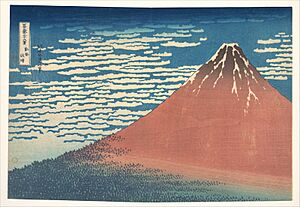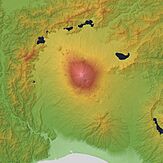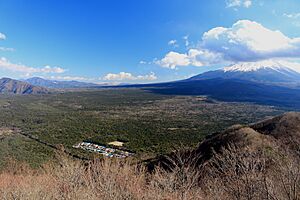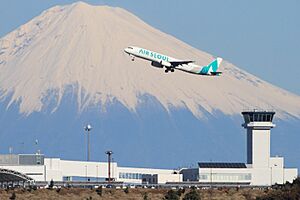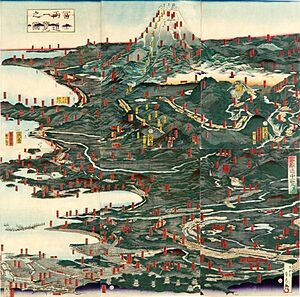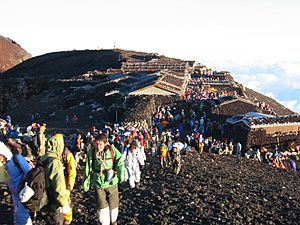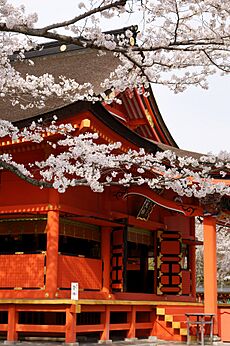Mount Fuji facts for kids
Quick facts for kids Mount Fuji |
|
|---|---|

Mount Fuji seen from Ōwakudani (2021)
|
|
| Highest point | |
| Prominence | 3,776 m (12,388 ft) Ranked 35th |
| Listing |
|
| Geography | |
| Location | Fuji-Hakone-Izu National Park |
| Country | Japan |
| Municipalities |
|
| Topo map | Geospatial Information Authority 25000:1 富士山 50000:1 富士山 |
| Geology | |
| Age of rock | 100,000 years |
| Volcanic arc | Izu–Bonin–Mariana Arc |
| Last eruption | 1707–08 |
| Climbing | |
| First ascent | 663 by En no Odzunu (役行者, En no gyoja, En no Odzuno) |
| Easiest route | Hiking |
| UNESCO World Heritage Site | |
| Official name | Fujisan, sacred place and source of artistic inspiration |
| Criteria | Cultural: iii, vi |
| Inscription | 2013 (37th Session) |
| Area | 20,702.1 ha |
| Buffer zone | 49,627.7 ha |
| Mount Fuji | |||||||
|---|---|---|---|---|---|---|---|

"Mt. Fuji" in kanji
|
|||||||
| Japanese name | |||||||
| Kanji | 富士山 | ||||||
| Hiragana | ふじさん | ||||||
|
|||||||
Mount Fuji (富士山・富士の山 (Fujisan, Fuji no Yama)) is a famous active volcano in Japan. It stands on the island of Honshu and is the country's highest mountain. Its peak reaches 3,776.24 m (12,389 ft 3 in) above sea level. Mount Fuji is also the second-highest volcano on any Asian island. Only Mount Kerinci in Indonesia is taller. It is also the seventh-highest island peak on Earth.
This beautiful mountain last erupted between 1707 and 1708. It is located about 100 km (62 mi) southwest of Tokyo. On clear days, you can even see it from the capital city! Mount Fuji has a very special, symmetrical cone shape. Snow covers its peak for about five months each year. This makes it a well-known Japanese cultural icon. Many artists and photographers feature it in their works. It is also a popular spot for sightseers, hikers, and mountain climbers.
Mount Fuji is one of Japan's "Three Holy Mountains" (三霊山, Sanreizan), along with Mount Tate and Mount Haku. It is considered a Special Place of Scenic Beauty and a Historic Site. In 2013, it was added to the World Heritage List as a Cultural Site. UNESCO recognized Mount Fuji for inspiring artists and poets for centuries. It has also been a place of pilgrimage. UNESCO lists 25 cultural sites around Mount Fuji. These include the mountain itself and the Shinto shrine, Fujisan Hongū Sengen Taisha.
Contents
- Discover Mount Fuji: Japan's Iconic Volcano
- What's in a Name? The Meaning of Fuji
- How Mount Fuji Got Its Name: A Look at History
- Mount Fuji Through Time: A Rich History
- Where is Mount Fuji? Its Location and Surroundings
- Mount Fuji's Weather: A Look at Its Climate
- How Mount Fuji Was Formed: A Geological Story
- Mount Fuji's Past Eruptions: A Timeline
- Is Mount Fuji Active? Understanding Eruption Risks
- Exploring Aokigahara Forest: Nature and Legends
- Planning Your Adventure: Climbing Mount Fuji
- Mount Fuji in Japanese Culture and Beliefs
- Related Pages
- See also
Discover Mount Fuji: Japan's Iconic Volcano
What's in a Name? The Meaning of Fuji
The Japanese name for Mount Fuji is Fujisan. The kanji characters used today for Fuji mean "wealth" (富) and "man of status" (士). However, the true origin of the name Fuji is still a mystery! These characters were likely chosen for their sound, not their meaning. The mountain was called Fuji long before these specific characters were used.
Some old stories try to explain the name. One tale from the 9th century, The Tale of the Bamboo Cutter, suggests the name comes from a word meaning "immortal" (不死, fushi). It also links to the idea of many "soldiers" (士, shi) climbing the mountain. Another old idea is that Fuji means "without equal" (不二) or "never-ending" (不盡).
A scholar from the Edo period, Hirata Atsutane, thought the name came from a word describing a mountain shaped like a rice plant's ear. A British missionary, John Batchelor, once suggested it came from an Ainu word for "fire." However, this idea is not accepted by modern experts. Today, many believe the name Fuji comes from an ancient Japanese language, not Ainu.
How Mount Fuji Got Its Name: A Look at History
In English, we call it Mount Fuji. Japanese speakers usually say "Fuji-san." The "san" here is not the polite ending used for people's names. Instead, it's the Japanese way of saying "mountain" (山, yama) when it's part of a compound word.
Over time, Mount Fuji has had other beautiful names. Some older or poetic names include "the Mountain of Fuji" (ふじの山, Fuji-no-Yama) and "the High Peak of Fuji" (ふじの高嶺, Fuji-no-Takane). It was also called "the Lotus Peak" (芙蓉峰, Fuyō-hō) and Fugaku. This last name combines the first character of Fuji with the character for mountain.
Mount Fuji Through Time: A Rich History
Mount Fuji is famous for its beautiful volcanic shape. It has been a popular subject in Japanese art for centuries. This became especially true after 1600, when Edo (now Tokyo) became the capital. People traveling the Tōkaidō road often saw the mountain. Historians say that in medieval times, Japanese people saw it as the "number one" mountain. It is mentioned in many Japanese poems and stories.
The summit of Mount Fuji was considered sacred long ago. For a long time, women were not allowed to climb it. This rule changed in 1872 when the Japanese government allowed everyone to climb for worship. Tatsu Takayama was the first Japanese woman known to reach the summit in 1832. The first foreigner to climb Mount Fuji was Sir Rutherford Alcock in 1860. Lady Fanny Parkes was the first non-Japanese woman to climb it in 1867.
Ancient samurai warriors used the base of the mountain for training. This was near the town of Gotemba. The shōgun Minamoto no Yoritomo even held archery contests there.
Today, Mount Fuji is a popular place for tourists and climbers from all over the world. There's a famous Japanese saying: "A wise person climbs Mt. Fuji once, but only a fool climbs it twice." This shows how challenging but rewarding the climb can be! Mount Fuji is still a strong symbol in Japanese culture. You can see it in movies, and it even inspired the Infiniti car logo.
In 2004, the weather station at the summit closed after 72 years. It was the highest weather station in Japan. Now, an automated system monitors the weather. Mount Fuji was officially added to the World Heritage List as a Cultural Site in 2013.
Where is Mount Fuji? Its Location and Surroundings
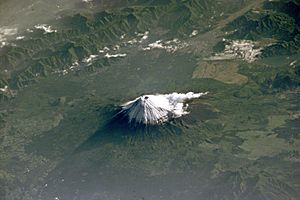
Mount Fuji is a very important landmark in Japan. It stands 3,776.24 m (12,389 ft) tall. You can find it near the Pacific coast of central Honshu, southwest of Tokyo. It sits on the border between Shizuoka and Yamanashi prefectures.
Several cities and towns surround the mountain. These include Gotemba to the east and Fujiyoshida to the north. Mount Fuji is also surrounded by five beautiful lakes: Lake Kawaguchi, Lake Yamanaka, Lake Sai, Lake Motosu, and Lake Shōji. These lakes offer amazing views of the mountain. The mountain is part of the Fuji-Hakone-Izu National Park. On clear days, you can see Mount Fuji from far-off cities like Yokohama and Tokyo. It has even been photographed from space!
Mount Fuji's Weather: A Look at Its Climate
The very top of Mount Fuji has a tundra climate. This means it's very cold at high altitudes. Snow covers the cone for many months of the year. The coldest temperature ever recorded was −38.0 °C (−36.4 °F) in February 1981. The warmest was 17.8 °C (64.0 °F) in August 1942.
Mount Fuji usually gets its first snowcap around October 2nd. In 2024, the snowcap formed on November 6th. This was the latest it had happened since records began in 1894.
| Climate data for Mt. Fuji (1991–2020 normals, extremes 1932–present) | |||||||||||||
|---|---|---|---|---|---|---|---|---|---|---|---|---|---|
| Month | Jan | Feb | Mar | Apr | May | Jun | Jul | Aug | Sep | Oct | Nov | Dec | Year |
| Record high °C (°F) | −1.7 (28.9) |
0.0 (32.0) |
1.0 (33.8) |
4.7 (40.5) |
12.2 (54.0) |
12.3 (54.1) |
17.4 (63.3) |
17.8 (64.0) |
16.3 (61.3) |
14.0 (57.2) |
6.9 (44.4) |
3.6 (38.5) |
17.8 (64.0) |
| Mean daily maximum °C (°F) | −15.3 (4.5) |
−14.3 (6.3) |
−10.9 (12.4) |
−5.9 (21.4) |
−0.6 (30.9) |
4.0 (39.2) |
8.0 (46.4) |
9.5 (49.1) |
6.5 (43.7) |
0.7 (33.3) |
−5.9 (21.4) |
−12.2 (10.0) |
−3.0 (26.6) |
| Daily mean °C (°F) | −18.2 (−0.8) |
−17.4 (0.7) |
−14.1 (6.6) |
−8.8 (16.2) |
−3.2 (26.2) |
1.4 (34.5) |
5.3 (41.5) |
6.4 (43.5) |
3.5 (38.3) |
−2.0 (28.4) |
−8.7 (16.3) |
−15.1 (4.8) |
−5.9 (21.4) |
| Mean daily minimum °C (°F) | −21.4 (−6.5) |
−21.1 (−6.0) |
−17.7 (0.1) |
−12.2 (10.0) |
−6.3 (20.7) |
−1.4 (29.5) |
2.8 (37.0) |
3.8 (38.8) |
0.6 (33.1) |
−5.1 (22.8) |
−11.8 (10.8) |
−18.3 (−0.9) |
−9.0 (15.8) |
| Record low °C (°F) | −37.3 (−35.1) |
−38.0 (−36.4) |
−33.9 (−29.0) |
−27.8 (−18.0) |
−18.9 (−2.0) |
−13.1 (8.4) |
−6.9 (19.6) |
−4.3 (24.3) |
−10.8 (12.6) |
−19.5 (−3.1) |
−28.1 (−18.6) |
−33.0 (−27.4) |
−38.0 (−36.4) |
| Average relative humidity (%) | 53 | 56 | 61 | 63 | 60 | 70 | 79 | 75 | 67 | 53 | 52 | 52 | 62 |
| Source: Japan Meteorological Agency | |||||||||||||
How Mount Fuji Was Formed: A Geological Story
Mount Fuji sits at a special place where three large pieces of Earth's crust, called tectonic plates, meet. These are the Eurasian Plate, the North American Plate, and the Philippine Sea Plate. The movement of these plates causes volcanic activity.
Mount Fuji's main crater is 780 m (2,560 ft) wide and 240 m (790 ft) deep. The slopes near the top are quite steep, about 31 to 35 degrees. Further down, the slopes become gentler.
Scientists believe Mount Fuji formed in four main stages. The first stage, called Sen-komitake, started with an ancient core deep inside the mountain. Then came "Komitake Fuji" hundreds of thousands of years ago. About 100,000 years ago, "Old Fuji" grew on top of Komitake Fuji. Finally, the modern "New Fuji" formed over Old Fuji about 10,000 years ago.
Over time, lava, ash, and small rocks have erupted from Mount Fuji. These eruptions created many features, including over 100 smaller cones around the main summit. There are also more than 70 lava tunnels and many lava tree molds.
As of 2002, Mount Fuji is considered an active volcano with a low risk of erupting soon. Its last big eruption was the Hōei eruption in 1707–1708. That eruption created a new crater and a second peak, called Mount Hōei, on its southeastern side. Since then, there have been no signs of another eruption.
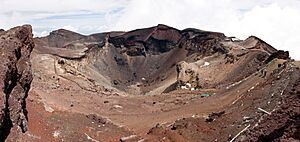
Mount Fuji's Past Eruptions: A Timeline
Here are some of the known eruptions of Mount Fuji:
| Date(s) | Notes |
|---|---|
| July 31, 781 | Records mention "ash fell," but details are scarce. |
| April 11 – May 15, 800 February 13, 802 |
During the first phase, the sky was dark even during the day. Later, gravel fell like hail. |
| June–September 864 December 865 – January 866 |
This eruption created three of the Fuji Five Lakes: Motosu, Shōji, and Saiko. They were once one large lake, separated by lava flow. |
| November 937 | This event was recorded in ancient Japanese texts. |
| March 999 | News of an eruption reached Kyoto, but specific details are unknown. |
| January 1033 | News of this eruption arrived in Kyoto two months later. |
| April 17, 1083 | A Buddhist monk recorded this eruption. The sound might have been heard in Kyoto. |
| between January 30, 1435, and January 18, 1436 | Records show a flame was visible on Mount Fuji. This was likely a lava flow. |
| August 1511 | Monks recorded a fire on Mount Fuji. This was also likely a lava flow. |
| December 16, 1707 | This was the famous Hōei eruption, the last major eruption of Mount Fuji. |
Is Mount Fuji Active? Understanding Eruption Risks
After the powerful 2011 Tōhoku earthquake, some people wondered if Mount Fuji might erupt again. Scientists use special models to estimate pressure inside the volcano. In 2012, some models suggested the pressure might be higher than before the 1707 eruption. However, directly measuring this pressure is not possible. So, these calculations are just estimates.
Other signs, like active steam vents, are normal for this type of volcano. They don't necessarily mean an eruption is coming soon.
Concerns about eruptions continued into the 2020s. In 2021, a new hazard map was created. It showed updated estimates for lava flow and new possible vents. This helped local residents plan for safety. Soon after, a small earthquake (magnitude 4.8) happened near Mount Fuji. However, the Japan Meteorological Agency confirmed that this earthquake did not increase the risk of an eruption. In 2023, a new evacuation plan was developed based on the updated hazard map. These plans help keep everyone safe.
Exploring Aokigahara Forest: Nature and Legends
At the northwest base of Mount Fuji lies the Aokigahara forest. This unique forest grew on ancient lava flows. It is known for its dense trees and quiet atmosphere.
Local folk tales and legends say that spirits and mythical creatures live in the forest. Hikers sometimes mark their paths with colored tape to avoid getting lost. This practice has raised concerns among officials about protecting the forest's natural environment.
Planning Your Adventure: Climbing Mount Fuji
Getting There: Transportation to Mount Fuji
The closest airport with international flights is Mt. Fuji Shizuoka Airport. It opened in 2009 and is about 80 km (50 mi) from Mount Fuji. Larger international airports near Tokyo, like Tokyo International Airport and Narita International Airport, are about three hours and 15 minutes away by car.
Choosing Your Path: Mount Fuji Climbing Routes
Around 300,000 people climbed Mount Fuji in 2009. The best time to hike is from July to August. During these months, the weather is warmest, and mountain huts are open. Buses to the starting points for climbers usually begin running on July 1st. Climbing from October to May is very risky due to severe cold and dangerous conditions.
Most Japanese climbers start their hike at night. They want to reach the summit by sunrise. The beautiful morning light at the top is called 御来光 goraikō, meaning "arrival of light."
There are four main routes to the summit, each with numbered stations. These are the Yoshida, Subashiri, Gotemba, and Fujinomiya routes. Climbers usually start from the "fifth stations," which you can reach by car or bus. The summit is considered the tenth station. The fifth stations are at different heights. Fujinomiya has the highest fifth station, followed by Yoshida, Subashiri, and Gotemba.
The Yoshida route is the most popular. It has a large parking area and many mountain huts for resting. The Fujinomiya route is the next most popular. Climbing from a fifth station can take five to seven hours to go up and three to four hours to come down. Many climbers enjoy descending the Subashiri and Gotemba routes because of their ash-covered paths, which can be fun to run down quickly.
There are also special paths for tractors that bring supplies to the mountain huts. These paths are usually off-limits to climbers for safety reasons. It's also illegal to camp above the fifth station in the national park.
At the summit, there are eight peaks around the crater. The highest point in Japan, Ken-ga-mine, is a popular spot for climbers to visit.
Soaring High: Paragliding Near Mount Fuji
Paragliders also enjoy Mount Fuji! They take off from areas near the fifth station, like the Gotemba parking lot. There are also other spots depending on the wind. Some paragliding schools use the wide, sandy slopes between the Gotemba and Subashiri parking lots for training.
Protecting Mount Fuji: New Rules for Hikers
To help manage the large number of visitors and keep everyone safe, new rules were put in place in 2024. The Yamanashi prefectural government introduced a mandatory fee of 2,000 yen (about $13) for hikers using the Yoshida trail. They also set a daily limit of 4,000 hikers on this trail. The trail is now closed between 4 p.m. and 3 a.m., except for guests staying in mountain lodges.
The Shizuoka prefectural government also closed the Subashiri, Gotemba, and Fujinomiya trails during the same nighttime hours. These measures aim to reduce crowding and improve safety for everyone enjoying Mount Fuji.
Mount Fuji in Japanese Culture and Beliefs
In Shinto mythology, Konohanasakuya-hime is the goddess of Mount Fuji. The Fujisan Hongū Sengen Taisha shrine is dedicated to her. Long ago, people worshipped the mountain from a distance. Shrines were built at its base to pray for protection from eruptions.
During the Heian period (794–1185), volcanic activity calmed down. Mount Fuji then became a center for Shugendō, a religion that combines mountain worship with Buddhism. Worshippers began to climb the slopes. By the early 12th century, a temple was founded on the summit.
A special group called Fuji-kō formed during the Edo period. They believed the mountain was a female deity and encouraged members to climb it. They thought climbing would bring rebirth and happiness. While this group is less active today, its ideas of mountain worship continue within some Shintō traditions.
Related Pages
See also
 In Spanish: Monte Fuji para niños
In Spanish: Monte Fuji para niños
- List of mountains and hills of Japan by height
- 100 Famous Japanese Mountains
- List of three-thousanders in Japan
- List of World Heritage sites in Japan
- List of elevation extremes by country
- Mount Araido (阿頼度山, Araidosan), Araido Island (阿頼度島), Kuril Islands





